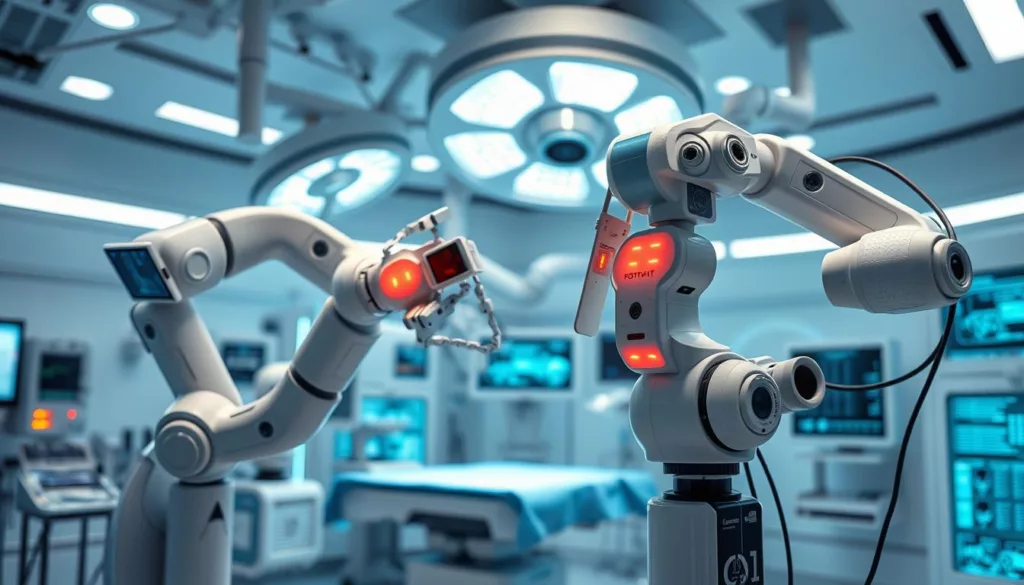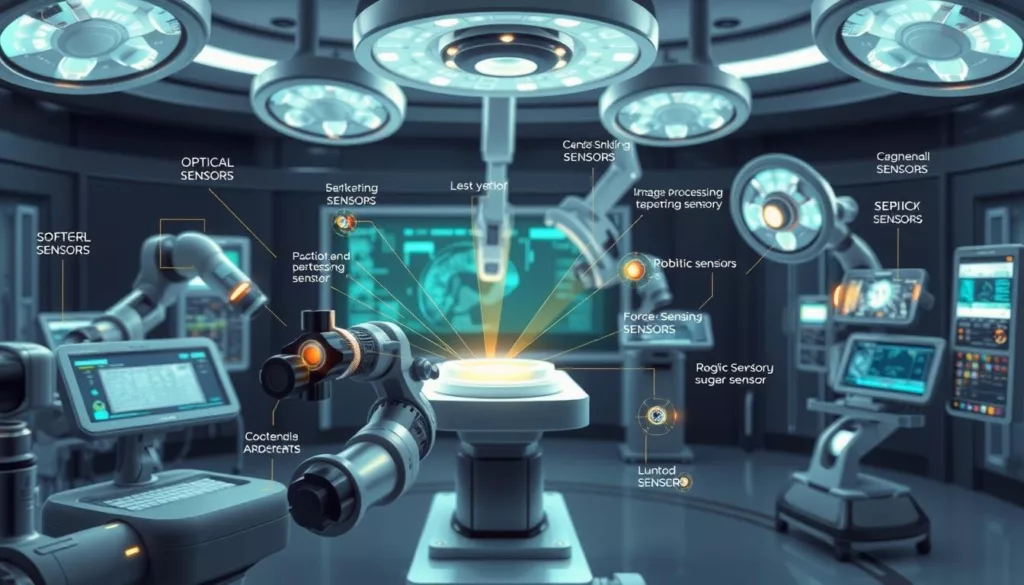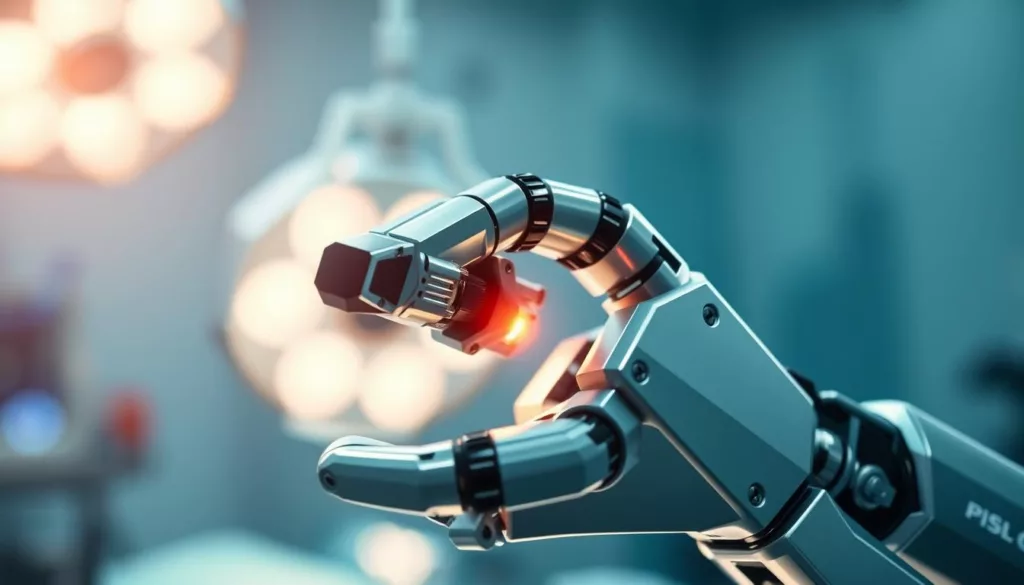Sensors in robotic surgery are key to making surgeries more precise and safe. Knowing about the different sensors used is important. They help surgeons do complex tasks with more confidence and accuracy.
We will look into how these sensors help in new surgical methods. The types range from vision to force and tactile sensors. This shows how important these technologies are in improving surgery.
Key Takeaways
- Sensors significantly enhance surgical precision and safety.
- Different types aim to refine robotic surgery instrument tracking.
- Technological advancements continue to improve sensor functionality.
- Key sensor categories include vision, force, and position sensors.
- Integration of sensors is critical for successful robotic surgeries.
Introduction to Sensors in Robotic Surgery
Sensors in robotic surgery play a key role in making surgeries better. They give real-time data and feedback, which helps keep the surgery precise and controlled. Knowing about these technologies is important for better surgical results in robotic surgery.
Advanced sensors help surgeons watch different things during surgery. For instance, force and torque sensors track the mechanical forces on objects. This helps surgeons use their tools better, reducing mistakes and risks during surgery.
These sensors also help collect data for improving surgical techniques. By using sensor technology, we can make robotic surgery better and safer for patients. Our commitment to providing sensor solutions, like those at XJCSENSOR, shows how important these tools are in advancing surgical robotics.
In short, sensors in robotic surgery improve performance and patient care. To learn more about sensor types, including force and torque sensors, visit this link.
Types of Sensors Used in Robotic Surgery Systems
It’s key to know the sensors in robotic surgery systems to improve results. These sensors are vital for precision and safety. They help make surgical robots work better and more safely.
Overview of Primary Sensor Categories
The main sensor types are:
- Vision Sensors: They help see the surgical area, giving the surgeon important images.
- Force Sensors: These measure the force used, making sure the robot applies the right pressure.
- Tactile Sensors: They mimic touch, helping the robot feel the texture and softness of tissues.
- Safety Sensors: These watch the environment, keeping the surgery safe.
Each type uses advanced tech for real-time feedback. This helps surgeons make better decisions during surgery.
Importance of Sensor Technology in Surgical Robotics
Sensor tech boosts what surgical robots can do. New tech leads to more precise surgeries, lowering risks and improving care. For example, better sensor design lets robots work better with different tissues and organs.
As sensor systems get smarter, so do surgical robots. This shows our dedication to top-notch medical tech.
Surgical Robotics Sensors and Their Role
Surgical robotics sensors are key in today’s surgeries. They help with precise movements and boost performance. These sensors make sure surgeons’ commands are carried out accurately. They also give vital feedback during the operation.
These sensors do more than just follow commands. They keep track of important details. This helps surgeons make better choices during complex surgeries. It leads to better results for patients.
There are different types of surgical robotics sensors. Each has unique abilities:
- Precision Tracking: Sensors track arm movements for accuracy.
- Tactile Feedback: Advanced sensors give real-time feedback. This helps surgeons work with soft tissues better.
- Parameter Monitoring: Sensors watch vital signs and other metrics. This makes surgeries safer.
Our team at XJCSENSOR is always looking to improve. We aim to give surgical teams the best tools. This will make robotic surgery more effective.
Vision Systems in Robotic Surgery
Vision systems are key in robotic surgery. They give surgeons clear views needed for precise and effective surgeries. Different vision sensors provide detailed images, helping teams see more during operations. This leads to better results and improved skills.
Types of Vision Sensors
Robotic surgery uses many vision sensors. Each one helps in its own way. Here are a few:
- Cameras: They show live video, helping surgeons make quick decisions.
- Infrared Sensors: These find temperature changes, spotting possible issues.
- Optical Systems: They improve image quality and depth, vital for detailed work.
Enhancing Precision with Imaging Technologies
New imaging tech has changed vision systems in robotic surgery. Better images and depth help surgeons see more clearly and act fast. High-definition and 3D views give a full picture of the area being worked on.
By using advanced vision systems, we show our dedication to top-notch sensor solutions. These improve how well surgeries are done.
Force and Tactile Sensors in Surgical Robots
Force and tactile sensors are key in surgical robots. They help surgeons do better in operations. These sensors give vital data for navigating complex surgeries.
They ensure surgeons have the right touch and control. This leads to better results for patients.
Working Principles of Force Sensors
Force sensors work by measuring the forces during surgery. They use strain gauges or piezoelectric materials. This lets them detect changes in pressure and force.
This data is important for checking how the surgeon interacts with tissues. It helps make adjustments during surgery. This makes the surgery more precise and reduces risks.
Benefits of Tactile Feedback in Surgery
Tactile feedback is very important in surgery. It gives surgeons real-time info on tissue interaction. By using tactile sensors, surgeons can feel the resistance and texture of tissues.
This helps them do delicate tasks. Surgeons can use their sense of touch while doing other things. This makes surgery better.
At XJCSENSOR, we know how important force and tactile sensors are. They make surgery safer and more effective.
Position and Motion Sensors for Surgical Robots
Position and motion sensors are key in surgical robots. They help the robot move exactly as the surgeon wants. Knowing about these sensors helps us see how they help in robotic surgery.
Types of Position Sensors
There are many types of sensors for robotic parts. Here are a few:
- Encoders: These turn motion into digital signals, giving exact position info.
- Gyroscopes: They detect changes in orientation, keeping the robot stable.
- Potentiometers: By measuring angle, they tell us where parts are.
Motion Tracking Technologies
Motion tracking is vital for robots to follow the surgeon’s hand. It uses different methods, like:
- Optical Tracking: Cameras and markers track the robot’s 3D position.
- Inertial Measurement Units (IMUs): IMUs use gyroscopes and accelerometers for precise control.
- Magnetic Tracking: It uses magnetic fields for wireless tracking, making surgery easier.
Using these sensors, surgical robots get very precise and reliable. At XJCSENSOR, we make sure robots have the best sensors for surgery.
| Sensor Type | Function | Advantages |
|---|---|---|
| Encoders | Converts motion into digital signals | High accuracy and resolution |
| Gyroscopes | Detects orientation changes | Maintains stability |
| Optical Tracking | Monitors position with cameras | High precision in 3D space |
| IMUs | Tracks motion using accelerometers | Responsive real-time data |
| Magnetic Tracking | Determines position via magnetic fields | Wireless flexibility |
Robotic Surgery Instrument Tracking
Accurate tracking of robotic surgery instruments is key to precise procedures and patient safety. In complex surgeries, real-time monitoring of instruments helps surgeons navigate tricky areas. This tracking reduces errors, leading to better results for patients.
Importance of Accurate Instrument Tracking
The instrument tracking importance is huge. These systems give feedback, helping teams check instrument positions during surgery. This feedback reduces mistakes and boosts confidence in the surgery.
- Enhances surgical precision by accurately positioning tools.
- Improves team communication and coordination during operations.
- Promotes patient safety by reducing risks associated with misplaced instruments.
- Facilitates efficient workflow by minimizing instrument retrieval time.
We’re committed to advanced sensor solutions for robotic surgery. Our tracking systems help surgeons perform at their best. For more on our sensor technology, check out our testing equipment page.
Investing in robotic surgery tracking is vital for precision and safety. As surgery techniques improve, the need for reliable tracking will grow. This will lead to more successful surgeries.
Robotic Surgery Safety Sensors
Safety is key in robotic surgery, where precision and reliability matter a lot. Safety sensors in robotic surgery are vital for protecting the surgical team and the patient. It’s important for medical professionals and engineers to know about these sensors.
Features of Safety Sensors
Robotic surgery safety sensors have advanced features to improve safety. They include:
- Emergency Stop Sensors: Stop robotic systems quickly in emergencies to prevent injury.
- Collision Detection Systems: Spot possible crashes, letting the robot dodge them.
- Load Sensors: Check the forces used during surgery, keeping them safe.
- Safety Interlocks: Make sure the system only works when it’s safe, keeping everything secure.
Compliance with Medical Safety Standards
Robotic surgery safety sensors must follow strict medical safety standards. They need to meet important regulations. Key standards include:
| Standard | Description |
|---|---|
| ISO 13485 | Focuses on quality management systems for medical devices. |
| IEC 60601 | Requires safety and effectiveness for medical electrical equipment. |
| FDA Guidelines | Regulates medical device safety and effectiveness in the U.S. |
By using safety features in surgical robotics that follow these standards, risks in surgery can be greatly reduced.
Sensor Integration in Surgical Robotics
In surgical robotics, sensors are key to better performance and precision. Integrating different sensors requires a detailed plan. This ensures all parts work together smoothly. It also makes data more accurate, helping surgeons make better decisions during surgery.
At XJCSENSOR, we work on creating sensor solutions that work well together. Our goal is to improve patient care by collecting and analyzing data in real-time. This integration helps reduce mistakes and improves surgery results.
- Utilization of modular design to enhance adaptability
- Implementation of advanced algorithms for data interpretation
- Customization of sensor configurations tailored to surgical needs
We aim to provide high-quality, customizable sensor solutions for robotic surgery. Our focus is on meeting the changing needs of surgical procedures.
| Aspect | Importance | Benefit |
|---|---|---|
| Modular Design | Facilitates easy upgrades | Increases longevity of systems |
| Advanced Algorithms | Enhances data accuracy | Improves decision-making |
| Customization | Addresses specific surgical requirements | Increases efficiency in operations |
We are committed to innovation in sensor solutions. Our work helps surgical professionals overcome challenges. This leads to better care for patients.
Multi-Sensor Fusion for Robotic Surgery
Using many sensors in robotic surgery, called multi-sensor fusion, makes surgery better. It uses different types of sensors to improve accuracy and strength. This makes surgeries more successful and flexible in the changing environment of the operating room.
Benefits of Multi-Sensor Approaches
Using multi-sensor fusion in robotic surgery has many benefits:
- Enhanced Accuracy: Mixing data from various sensors makes operations more precise. It helps overcome the weaknesses of any single sensor.
- Robust Performance: With different sensors, the system works well even in tough situations. This ensures it’s reliable during important surgeries.
- Greater Adaptability: Systems using different sensing methods can quickly adapt to different surgical needs.
Challenges in Sensor Integration
Even with the benefits of multiple sensors, there are sensor integration challenges:
- Data Fusion Complexities: Combining data from different sensors requires advanced algorithms. These are needed to keep the data accurate and consistent.
- Real-Time Performance: It’s essential to process sensor data quickly. This is a challenge in making the system efficient.
- Calibration and Synchronization: Making sure all sensors are calibrated and in sync is key. This adds complexity to the system.
Conclusion
Sensor technology in robotics has changed surgery forever. We’ve seen how vision, force, and motion sensors improve surgery. They make procedures more precise and safe.
These sensors are key to better surgery results. Their accuracy is vital for successful operations.
New sensor technologies are making surgery smarter. This is just the start of something big. At XJCSENSOR, we’re leading the way with top-notch sensor solutions.
These solutions help surgeons do their best work. They also improve care for patients.
The future of surgery looks bright with better sensors. We’re all about pushing the limits of surgical robotics. Our goal is to keep our partners ahead with the latest in sensor tech.
Together, we can make surgery better for everyone. Let’s explore this exciting future together.






